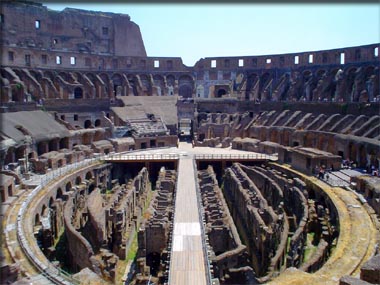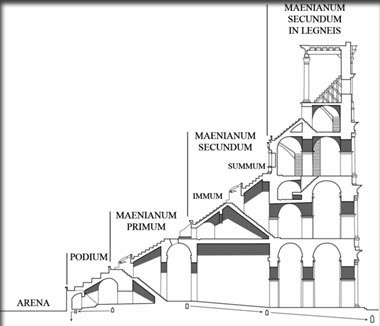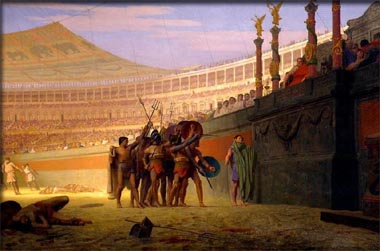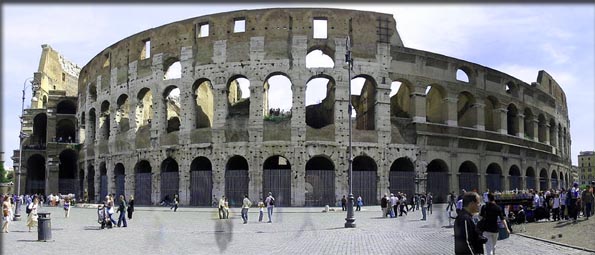 |
Coliseum:
The Great Arena
|
In 69 AD, Vespasian was declared Emperor of Rome
after a year long civil war. Some of his first acts as the new
ruler were to rebuild parts of Rome damaged during the hostilities.
One of the projects that he started was the construction of
an immense stadium. The Flavian Amphitheater, as it was
then known, would become the largest public entertainment venue
in the Roman Empire and eventually a symbol of the city of Rome
itself. For 18 centuries it remained the largest amphitheater
in the world. Today we call this zenith of Roman architecture
and engineering the Coliseum.
In 64 AD under the Emperor Nero, the city of Rome
had suffered a devastating fire. Rumors had it that Nero had
started the fire himself in order to clear land for his new
palace and gardens. Later it was in this garden area, known
as the Domus Aurea, that Vespasian decided to build the
Coliseum. The new Emperor wanted to show that he was returning
some of the land Nero had acquired for himself back to public
use.
Construction
|
Seven
Quick Facts
|
| Seating
capacity: 50,000 - 55,000 |
| Exterior
Size: 615 long (187m), 510 feet wide (155m) and 159
feet high (49m) |
| Constructed
from: 72 AD to 80 AD |
| Function:
Stadium for Roman spectacles , mainly gladiatorial
games and hunts. |
| Built
by: Emperors Vespasian and Titus. |
| Made
of: Travertine limestone with brick and concrete
in some sections. |
| Other:
Largest amphitheater in the world for 18 centuries. |
Construction on the site started in 72 AD when
an artificial lake in the former pleasure garden was filled
in. The shape of the structure was laid out as a huge ellipse
measuring 615 long (187m) and 510 feet wide (155m) on a foundation
40 feet (12m) deep. The exterior walls, constructed of blocks
of travertine limestone, rose in three layers (known as arcades)
composed of arches flanked by columns. Each level used a different
type of column: Doric on the ground level, Ionic on the second
level and Corinthian on the third level. After Vespasian died
in 79 AD, his son, the Emperor Titus, added a fourth level consisting
of an attic that had no arches but small rectangular windows
instead. Corinthian pilasters (a low relief, square-shaped
column) were used in the facade on the fourth level. This final
section pushed the height of the stadium up to 159 feet (49m).
Below the floor of the arena (which measured 157
by 272 feet - 48m by 83m) was a two level basement area known
as the hypogeum. It was here that people and animals
would wait before being brought out into the performance area.
There were at least eighty vertical shafts that provided access
from the hypogeum to the surface using a surprising array of
advanced hydraulic-powered machinery. This allowed people, animals
and scenery to be lifted by elevator to the floor of the Coliseum.
Hinged ramps were also used for large animals like elephants.
The roof of the hypogeum was made of timber and on top of that
was laid a layer of sand (in fact the word for sand in Latin
is arena) that made up the floor of the Coliseum.
|

Part
of the floor of the arena had been restored, but the chambers
that made up the hypogeum can still clearly be seen. (Photo
by Bjarki Sigursveinsson and released to public domain)
|
The hypogeum had underground access to several
of the surrounding buildings. This permitted the Emperor and
other dignitaries to come and go without mixing with the crowd.
There were also underground tunnels that ran to the gladiators'
barracks and the nearby stables.
Seating
The seating arrangements in the stadium represented
the stratified organization of Roman society. The Emperor had
a lavish box for himself and his guests next to the stadium
floor. The other seats next to the floor around the sides of
the arena were given over to senators. Behind them was a class
of nobles known as the equestrians. The next level back
was for ordinary Roman citizens known as plebeians (the
richer ones got to sit closer in a section called the immum
while the poorer ones were back in an area known as the
summum). Up in the attic was a section called the maenianum
secundum in legneis where the common poor, slaves and women
could stand or sit on steep wooden benches. At the very top
of the structure over the attic was a large awning called the
velarium which could be deployed over the seats to keep
the sun off the throng.
Some ancient documents say that the Coliseum could
accommodate a crowd of 87,000 people. Modern estimates, however,
have put that figure between 50,000 and 55,000. In any case,
with such large crowds the ancient designers faced some of the
same problems that architects of modern stadiums do: the passageways
had to be large and numerous enough to quickly evacuate the
building in an emergency. The Coliseum had eighty entrances/exits
at the ground level of the structure for this purpose. Four
of these were reserved for the elite, while the rest were used
for ordinary spectators. Pieces of pottery with the seat locations
written on them were used for tickets.
|

This
diagram shows a cross-section of the Coliseum's seating.
|
The original name of the structure was the Flavian
Amphitheater as Flavius was the family name of both Emperor
Vespasian and his son Titus. The name Coliseum probably
came from a colossal statue of Nero that stood near the building.
After Nero's reign, later emperors changed the head of the sculpture
to make it appear as the god Apollo. It is thought that eventually
the colossus name became associated with the amphitheater and
stuck even after the statue itself was destroyed around the
5th century AD.
Entertainment
Perhaps the most popular games at the Coliseum
were gladiatorial bouts. Gladiators were armed fighters who
would often battle to the death for the entertainment of the
crowd. Animal hunts, known as venatio, were also popular.
These were often done with elaborate scenery to mimic a natural
environment. Many beasts, imported from places like Africa and
the Middle East, were used in the show. Large numbers of lions,
tigers, bears, rhinoceros, hippopotamuses, elephants, giraffes
and crocodiles were all slaughtered in the stadium. It is said
that when the Emperor Trajan hosted bouts at the Coliseum to
celebrate his victories in Dacia in 107 AD he used 11,000 animals
and 10,000 gladiators.
Gladiators were usually convicted criminals or
prisoners of war. They were given special training in the martial
arts at gladiator schools owned by wealthy Romans. Though most
died in the arena, a few extremely successful ones who survived
long enough became popular heroes and lived to retire.
The Roman crowd had an appetite for cruel entertainment
and the sand of the arena floor was often soaked with blood
from these gory spectacles. In addition to fights to the death
and the hunting of exotic animals, the arena was also used for
simple executions of prisoners or undesirables. They might be
killed by the sword, shot with arrows or thrown to hungry lions.
|

Gladiators
salute the Emperor in the painting by Jean-Léon Gérôme.
Note the velarium in the background.
|
According to ancient records the floor of the
Coliseum could also be flooded so that navalia proelia
(simulated sea battles) could be done before the audience. While
water would have easily been available for such a display from
Rome's aqueducts, it isn't clear to modern archeologists how
the floor of the stadium could have been waterproofed with the
hypogeum below. Some have suggested either these sea battles
were actually performed at a different location or were done
in the early years of the stadium before the hypogeum was built.
There is a long tradition that early Christian
believers were martyred in large numbers on the floor of the
Coliseum, but historical research suggests this actually occurred
instead at the Circus Flaminius near the Tiber River.
In the Middle Ages the Coliseum was not considered a sacred
site by Christians, which would have been expected if martyrs
had been killed at that location. The tradition identifying
the Coliseum as a location of martyrdom appeared only in the
16th and 17th centuries, over a thousand years after such incidents
might have happened.
Last
of the Games
In 312 AD, Emperor Constantine converted to Christianity
and moved his capital to Constantinople. The city of Rome went
through a slow decline after that with the gladiatorial games
ending in 404. For a while the building served as a church and
later was fortified as a castle. As time passed it was abandoned
as earthquakes toppled about half of the structure's outer wall.
The remains acted as a quarry and much of the travertine stone
was recycled into other buildings. In 1744 the Pope Benedict
XIV put an end to this practice as he saw the site as a sacred
location.
The Coliseum still stands in the heart of Rome
today. Even though a third of its original structure has fallen,
the building is still overwhelmingly impressive and thousands
of visitors tour the ancient stadium each year and marvel at
its grandeur.
|
Because
much of the outer wall of the Coliseum has collapsed,
only about two-thirds of its original structure still
stands. (Photo by ScubaBeer licensed
under the Creative
Commons Attribution-Share Alike 2.0 Generic license)

|

Copyright
2012 Lee Krystek. All Rights Reserved.